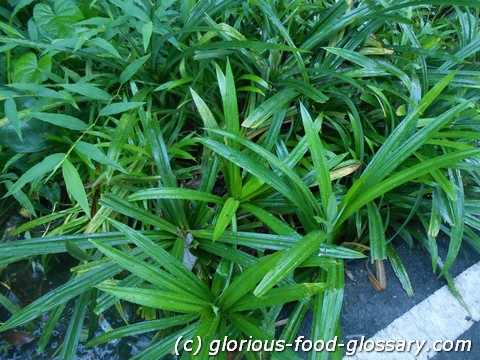Deutsch: Pandan-Blätter / Español: Hojas de Pandan / Português: Folhas de Pandan / Français: Feuilles de Pandan / Italiano: Foglie di Pandan
Dahon ng Pandan in the food context refers to the leaves of the Pandanus amaryllifolius plant, widely used in Southeast Asian cuisine for their unique, sweet, and fragrant aroma. These leaves are typically used to infuse rice, desserts, and drinks with a distinct flavor and a subtle grassy note. The vibrant green color of pandan leaves can also be extracted and used as a natural coloring in foods, making dishes not only flavorful but visually appealing as well.
Description
The use of Dahon ng Pandan is prevalent in the culinary traditions of countries like the Philippines, Thailand, Malaysia, and Indonesia. When cooked, pandan leaves release a fragrant aroma often compared to vanilla with hints of coconut. Though not typically consumed directly, the leaves are either tied in knots and simmered with food to impart their flavor or ground to extract the juice for use as a coloring and flavoring agent.
Application Areas
Pandan leaves are versatile and find applications in various culinary contexts, such as:
- Flavoring Rice: Cooked with rice to impart a fragrant aroma, as seen in dishes like the Filipino pandan rice or the Thai jasmine rice.
- Desserts and Sweets: Used to flavor a wide array of desserts, including cakes, puddings, jellies, and sweet drinks.
- Natural Food Coloring: The green juice extracted from pandan leaves is used to naturally color foods and beverages.
Well-Known Examples
Some well-known dishes and preparations using Dahon ng Pandan include:
- Buko Pandan: A Filipino dessert made from young coconut, pandan-flavored gelatin, and cream.
- Pandan Cake: A light, fluffy sponge cake flavored with pandan juice, popular in Southeast Asia.
- Pandan Chicken: Chicken wrapped in pandan leaves and fried or grilled, imparting a subtle aroma to the meat.
Recipes
A simple way to incorporate Dahon ng Pandan into cooking is through pandan-infused rice:
-
- 1 cup of jasmine rice or any preferred type of rice
- 1-2 pandan leaves, tied into a knot
- Water, as needed for cooking the rice
-
Preparation:
- Rinse the rice until the water runs clear to remove excess starch.
- Add the rice to a pot or rice cooker, along with the appropriate amount of water according to the rice type.
- Place the knotted pandan leaves on top of the rice.
- Cook the rice as usual. Once done, remove the pandan leaves before serving. The rice will have a subtle pandan aroma and flavor.
Treatment and Risks
Dahon ng Pandan is generally safe to use in cooking and has no known adverse health effects when used as a flavoring or coloring agent. However, the leaves themselves are tough and fibrous, making them inedible in their whole form. Always remove the leaves from the dish before consumption.
Similar Terms or Synonyms
- Pandan Leaves
- Screwpine Leaves (an alternative English term)
Summary
Dahon ng Pandan are the leaves of the Pandanus amaryllifolius plant, treasured in Southeast Asian cuisine for their fragrant aroma and ability to naturally color foods. They are used in a variety of dishes, especially in rice, desserts, and beverages, adding a unique flavor profile that is distinctively aromatic. The versatility and culinary applications of pandan leaves highlight their significance in traditional and modern Southeast Asian cooking.

Related Articles to the term 'Dahon ng Pandan' | |
| 'Pandan' | ■■■■■■■■■■ |
| Pandan is the Filipino term for \'fragrant screwpine\' . The leaves of Pandan are mostly used to perfume . . . Read More | |
| 'Glutinous' | ■■■■■■■■ |
| Glutinous is a word to describe something as having the nature of glue sticky, such as Glutinous rice . . . Read More | |
| 'Cendol' | ■■■■■■■ |
| Cendol is an Indonesian drink which is made with brown sugar, jackfruit, gelatin, coconut milk and the . . . Read More | |
| 'La Dua' | ■■■■■■■ |
| La Dua is the Vietnamese word for Pandan Leaves. It is a a common southern Vietnam ingredient. They are . . . Read More | |
| 'Aceite' | ■■■■■■■ |
| Aceite is the Spanish word for any kind of edible \'Oil\'. Among the Edible oils used for cooking are: . . . Read More | |
| 'Fruity' | ■■■■■■■ |
| Fruity is a tasting term used to describe wines or foods with aromas and flavors reminiscent of fresh . . . Read More | |
| 'Kakanin' | ■■■■■■■ |
| Kakanin is a Filipino term used to refer to a wide variety of traditional Filipino rice cakes. These . . . Read More | |
| 'Sibuyas' | ■■■■■■■ |
| Sibuyas, in the food context, refers to onions. Onions are a widely used and versatile vegetable in culinary . . . Read More | |
| 'Spice plant' | ■■■■■■■ |
| Spice plant refers to any plant that is grown or harvested primarily for the spices or seasonings that . . . Read More | |
| 'Bataw' | ■■■■■■■ |
| In the food context, \'Bataw\' refers to the hyacinth bean or lablab bean (Lablab purpureus), similar . . . Read More | |
